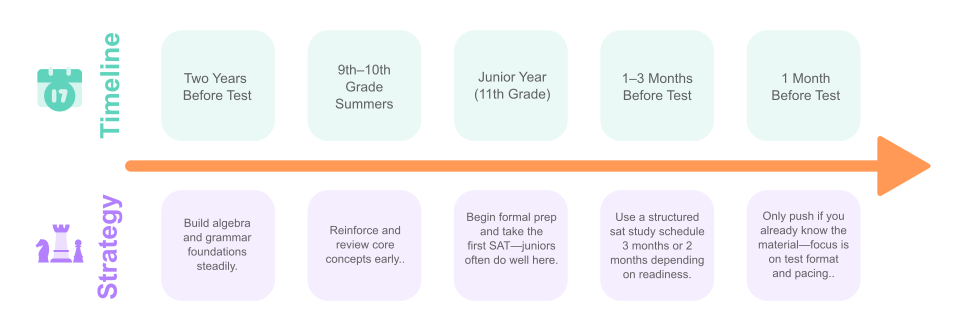When it comes to crafting the right SAT Study Schedule, timing is everything. The earlier and smarter you begin, the less crammed and more confident the preparation feels. But when exactly should you start? Here’s a clear roadmap to guide your planning.
Early Foundation: Start as Early as 8th Grade
A strong SAT preparation schedule truly begins in 8th grade. That summer is prime time for starting the journey: reviewing earlier school concepts, practicing critical thinking, and exploring SAT-style questions bit by bit. As concepts like graphing, polynomials, and quadratic equations are introduced in 9th and 10th grade, building familiarity early puts you miles ahead.
The Best Time to Take SAT
According to the College Board, the SAT is typically offered seven times a year: March, May, June, August, October, November, and December. While 11th grade is generally the best time to take it, confident students may sit for it as early as 10th grade—provided they’ve mastered the fundamentals of algebra, graphing, and grammar. Without these foundations, tackling the SAT can feel like running a marathon without training. Picking your exam date with preparation time in mind ensures not just completion, but real confidence on test day.
What a Smart SAT Study Routine Looks Like
Depending on how early you start, here’s how the SAT Study Schedule plays out:
- Long-term (2+ years)
Ideal for students with gaps in foundational math and language skills. Starting in 8th or early 9th grade allows time to build, review, and grow steadily—a well-paced SAT preparation schedule that’s nurturing and sustainable. - Moderate-term (2–3 months)
Works well if you have a solid base but needs focused review. This SAT prep schedule allows time to reinforce weak areas and increase confidence. - Short-term (1 month)
Planning a SAT Study Schedule 1 month earlier is only effective if you are already comfortable with key concepts like graphing and quadratics. At this stage, the focus is on mastering test tactics and timing—not teaching basics.
Key Strategic Windows
Creating a successful study schedule for SAT means matching prep to both readiness and test dates:

Why This Matters?
Without a foundation built over time, last-minute prep becomes stressful and less effective—no amount of cramming can substitute for years of cumulative learning. A thoughtful SAT study routine aligns with your current grasp of material, test availability, and emotional readiness.
